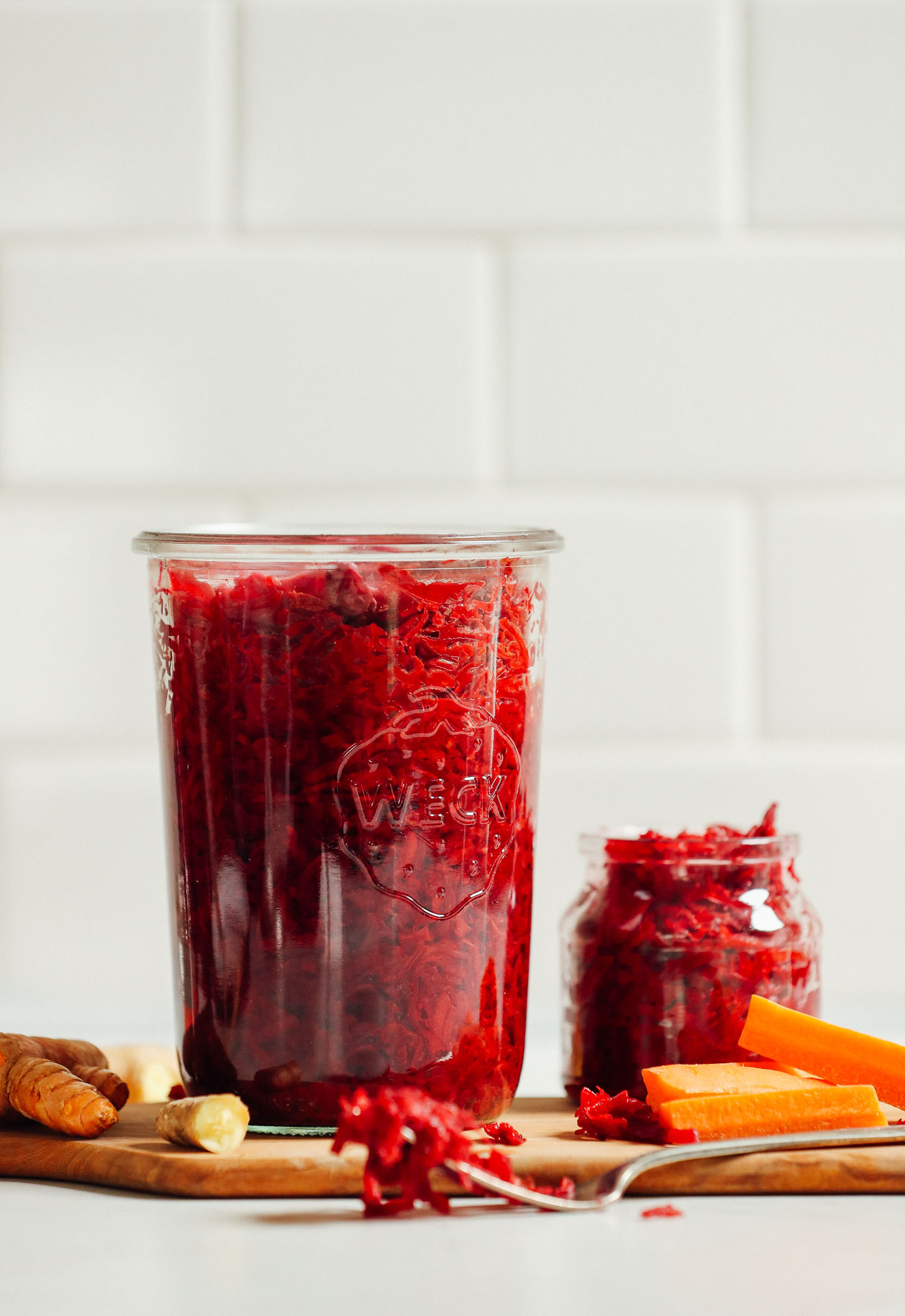
My first experience with sauerkraut was when I was working at a sandwich shop in college. The rule was if you showed up late you had to make the “sauerkraut.” It was kind of awful because the sauerkraut was pre-made and came in a giant can, and once you got past the smell, you had to mix it with mayonnaise. Needless to say, it was one of my least favorite tasks and a major motivator to get to work on time.
This sauerkraut, however, is nothing like that. It’s homemade from scratch with simple ingredients to help promote a healthy gut (and there’s no mayonnaise in sight). Plus, it’s super easy to master the technique and requires just 7 simple ingredients. Shall we?
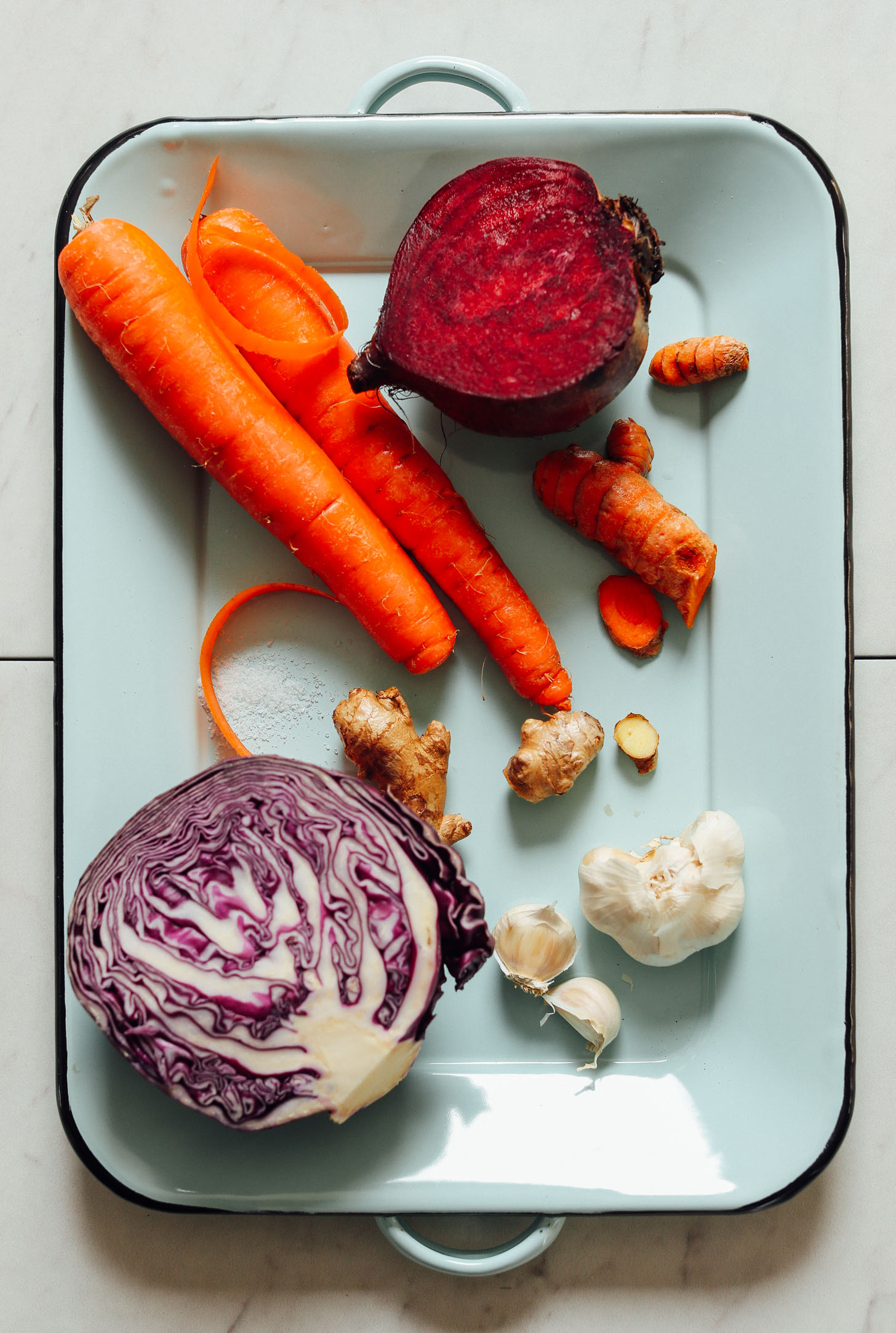
What is Sauerkraut?
Sauerkraut is a fermented food made from cabbage. It has been consumed for thousands of years for its probiotic benefits and is rich in vitamins C, B, A, K, and a variety of minerals.
It has a tangy flavor, crunchy texture, and is simple and cost-effective to make at home!
Origins of Sauerkraut
You may have heard that sauerkraut was a German invention, but that’s not necessarily true! Who knew!?
Instead, sauerkraut is thought to have originated in northern China. It made its way to Europe about 1000 years later and was eaten by Dutch seafarers as a way to prevent scurvy, due to sauerkraut’s vitamin C content. (source)
How to Make Sauerkraut
The simplest form of sauerkraut is just cabbage and salt, which is where we start in this recipe.
Once the salt is added, simply massage with clean hands for 10 minutes or until the cabbage has reduced quite a bit in size and released quite a bit of liquid at the base of the bowl. See the progression in the next two photos.
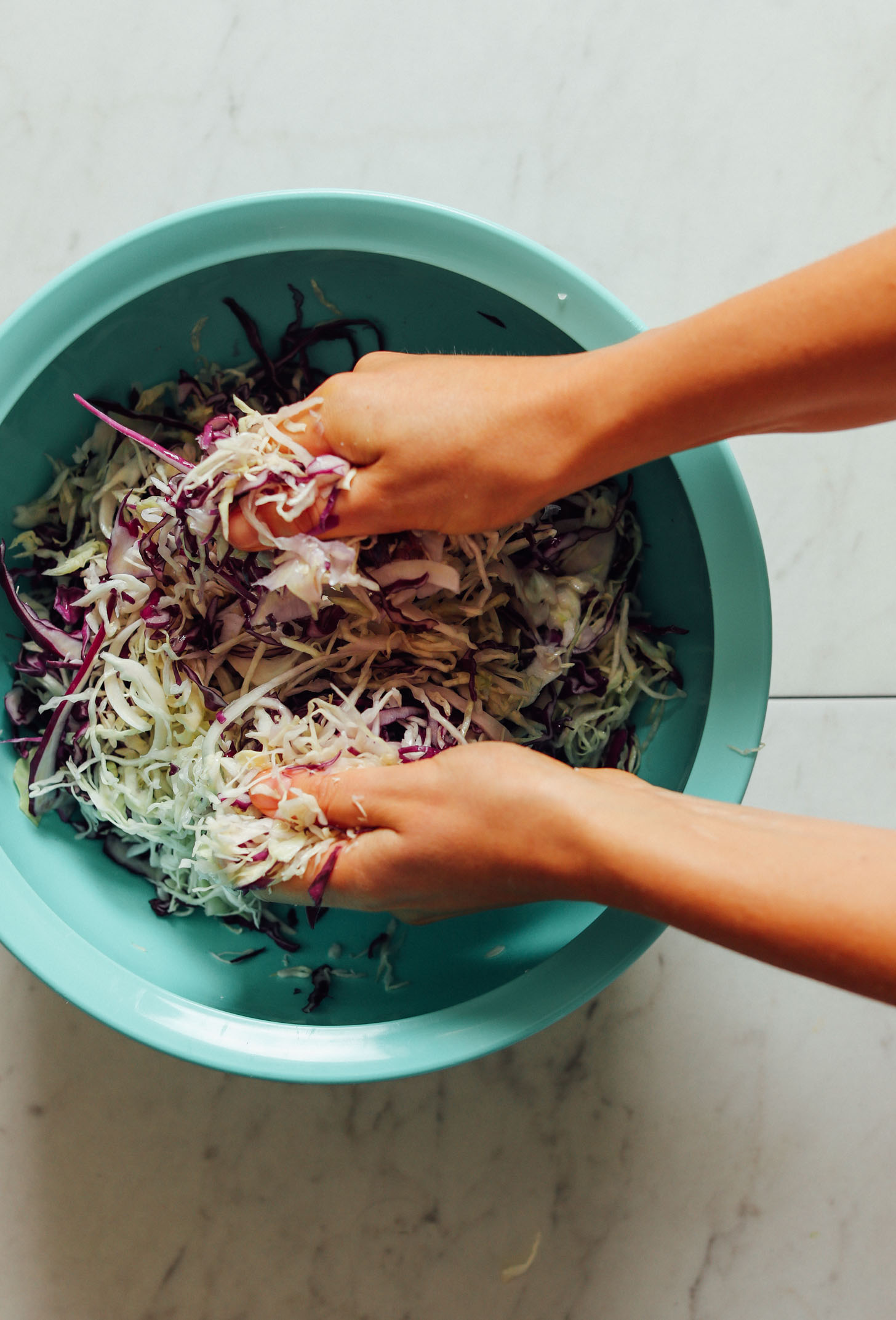
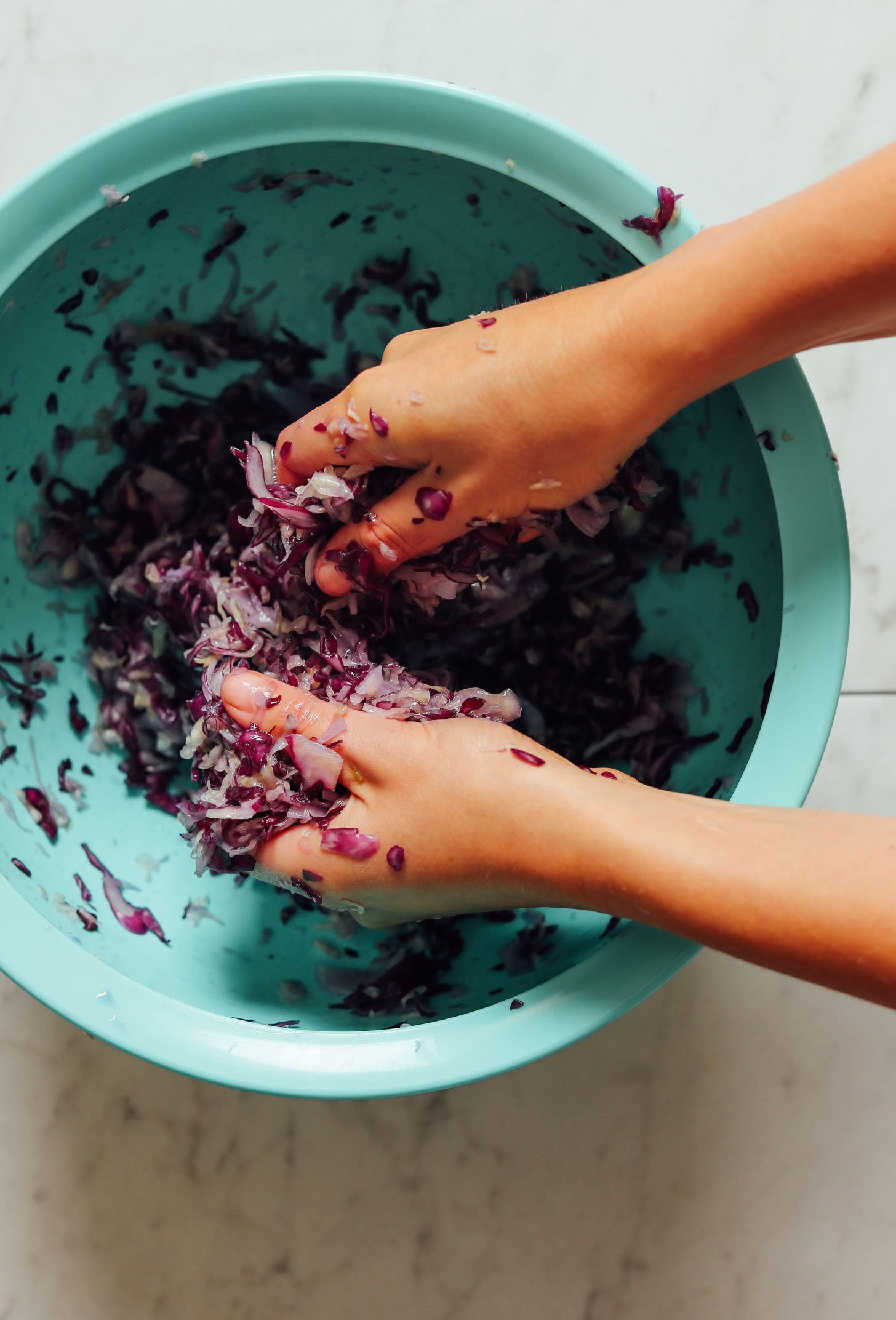
We’re looking good! Now, let’s add some color and flavor.
I went with shredded carrots and beets, which provide a vibrant orange-magenta hue. Next come fresh minced garlic and fresh grated ginger and turmeric for big flavor. The result is a perfectly salted fresh vegetable sauerkraut infused with zesty garlic and ginger and earthy turmeric. Swoon!
Mix again to incorporate and you’ve practically made sauerkraut!
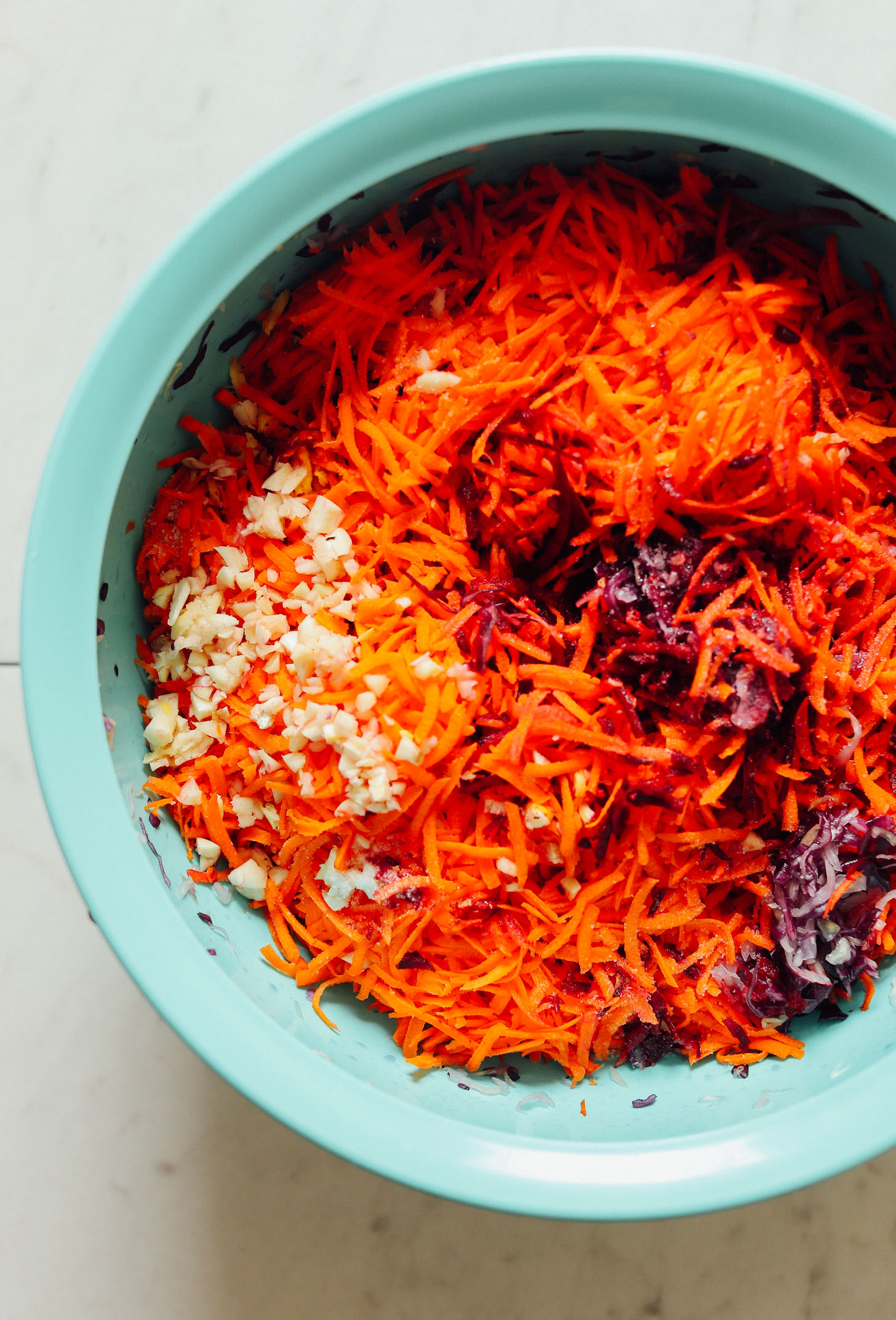
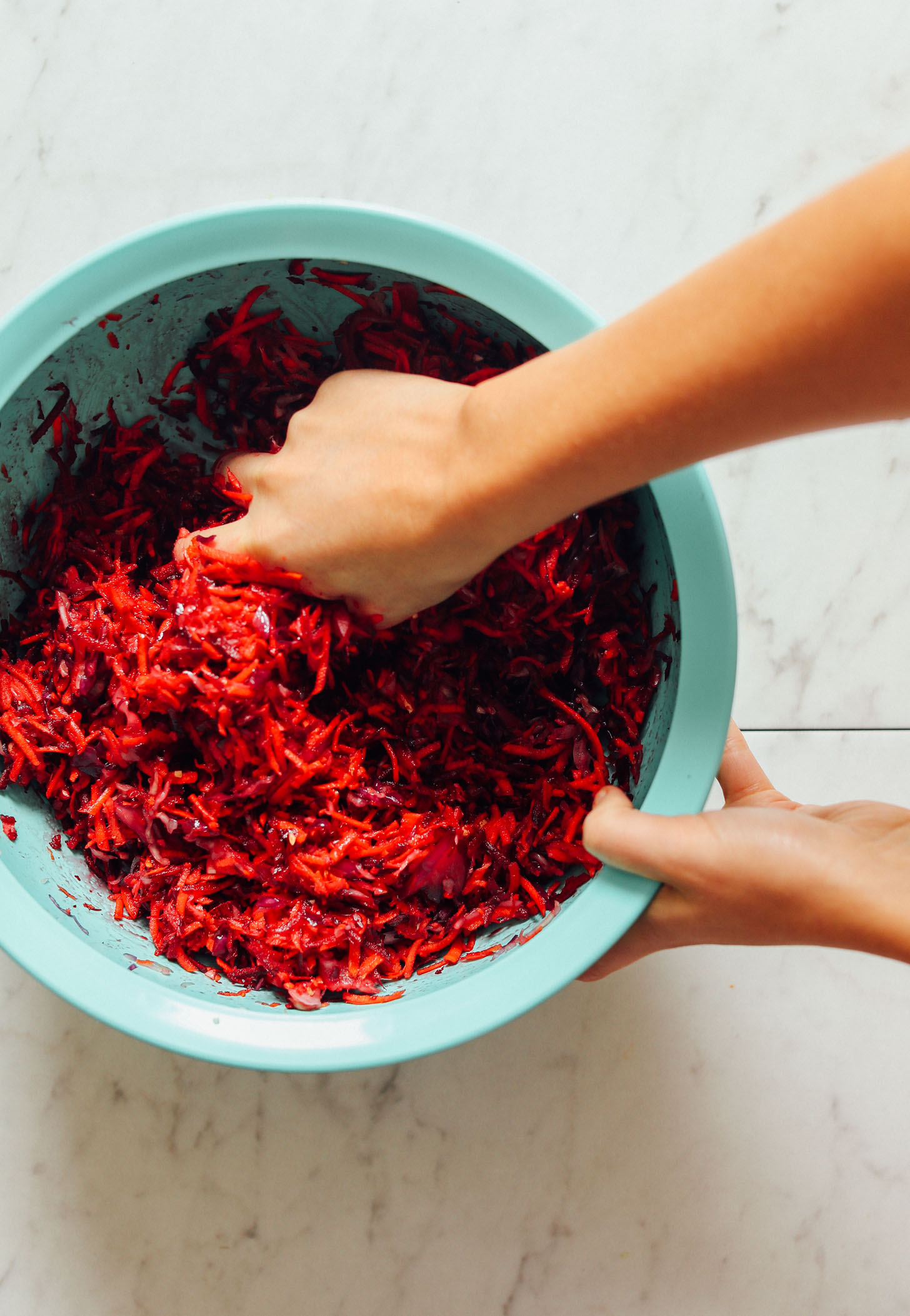
All that’s left to do is pack into sterilized jars and ensure the liquid extracted from all that massaging rises up and covers the kraut for optimum fermentation. Then leave it alone to do its thing. Set it on the counter out of direct sunlight or in a cabinet for 1-14 days (or longer) to let it naturally ferment.
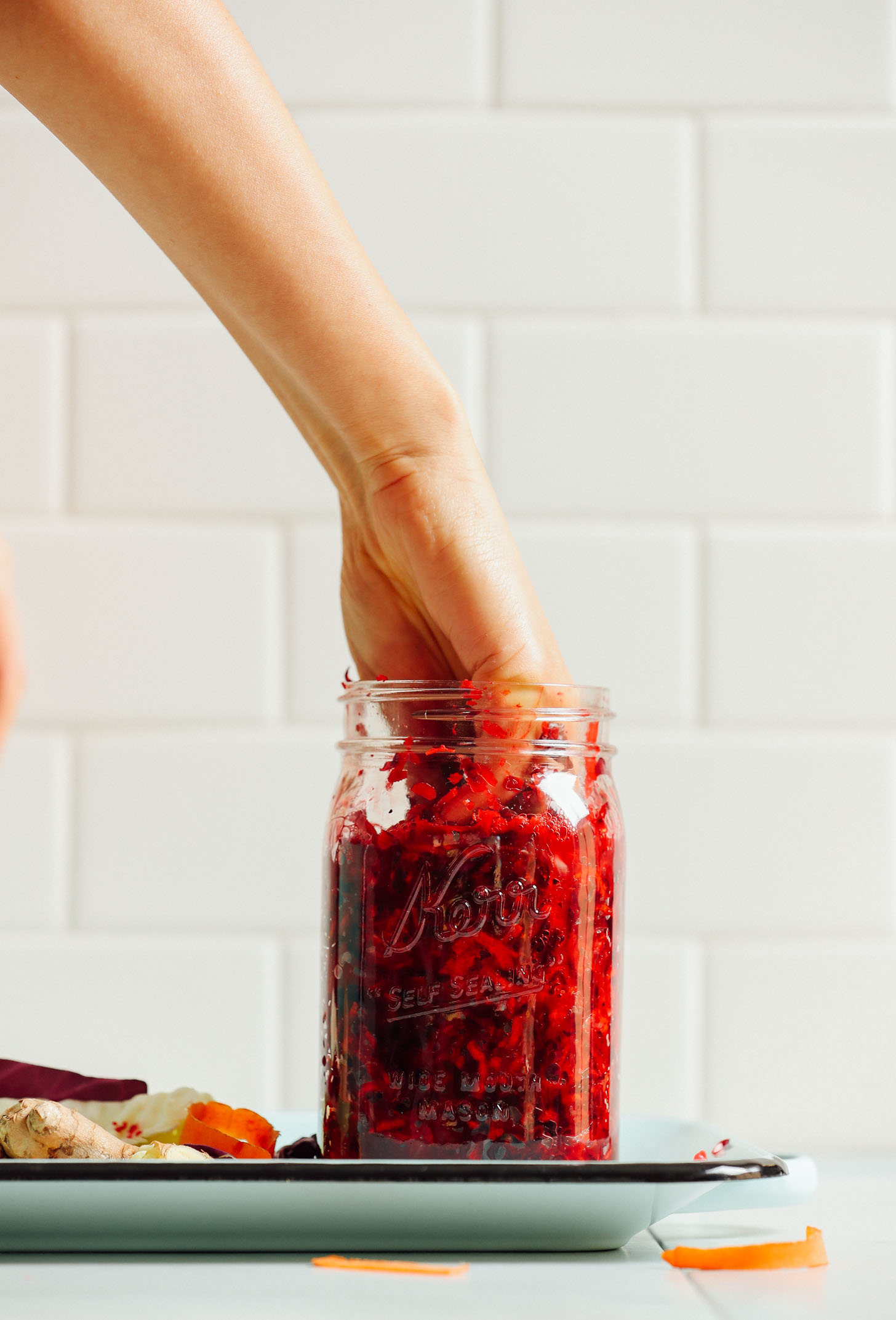
We hope you LOVE this kraut! It’s:
Tangy
Crunchy
Fresh
Filled with probiotics
Garlicky
& So delicious
This would make the perfect topper for sandwiches, salads, wraps, bowls, and more! Our favorite way to enjoy sauerkraut is with dishes like Kitchari or Garlicky Kale Salad with Crispy Chickpeas. But it’s even tasty right out of the jar (just don’t double dip to avoid contamination).
More Probiotic-Rich Recipes
If you’re into fermented things, be sure to also check out our Easy Vegan Kimchi, Mango Coconut Yogurt, Cultured Vegan Sour Cream, Probiotic-Cultured Vegan Cheese, and 2-Ingredient Coconut Yogurt!
If you try this recipe, let us know! Leave a comment, rate it, and don’t forget to tag a photo #minimalistbaker on Instagram. Cheers, friends!
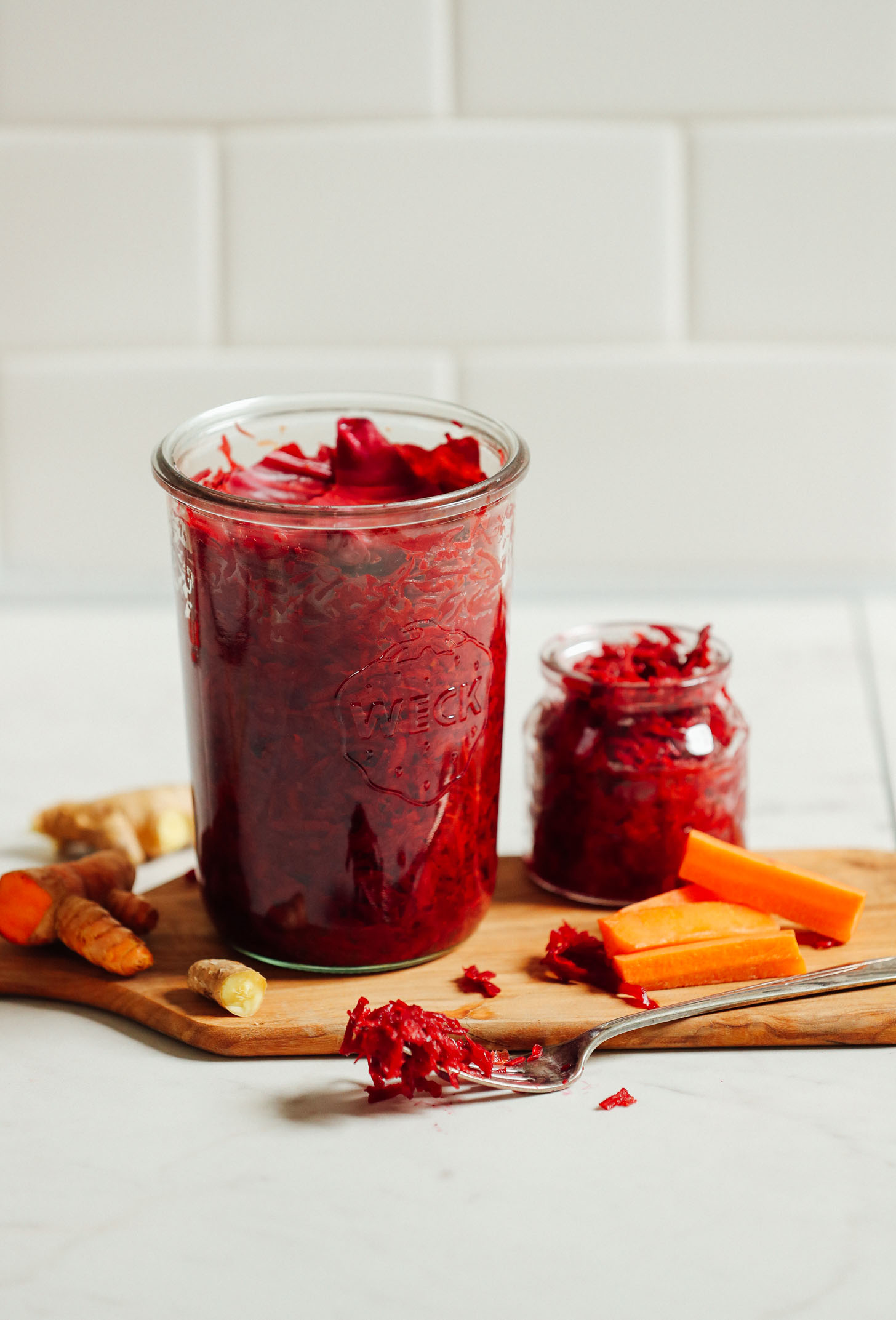
How to Make Sauerkraut
Ingredients
- 8 cups red or green cabbage (finely grated or chopped)
- 1 ½ – 2 tsp sea salt (plus more to taste)
- 1 small beet (finely shredded)
- 3 whole carrots (finely shredded)
- 3 Tbsp fresh ginger (shredded / grated)
- 3 Tbsp fresh turmeric (shredded / grated)
- 4 cloves garlic (finely minced)
Instructions
- Sterilize any equipment you will be using for fermentation, especially the jars (we prefer using mason jars or these Weck Jars that are about 850 ml). It is extremely important that everything is sterilized to allow for proper fermentation. Do so easily by pouring boiling water over clean jars and lids and drying completely. Let come back to room temperature before adding ingredients.
- Add finely grated cabbage (we used our mandolin) to a large mixing bowl and top with 1 ½ teaspoons sea salt (or the lower end of the suggested range if making a different batch size). Wash hands thoroughly and massage cabbage for ten minutes. The cabbage should start softening, shrinking in size, and releasing water (see photo). Continue massaging until this happens.
- Add shredded beet, carrot, ginger, turmeric, and garlic and massage once more with clean hands for 4-5 minutes until thoroughly combined (see photo). Then taste test and adjust flavor, adding more salt for saltiness, grated ginger for more zing, or garlic for more intense garlic flavor.
- Use your clean hands to put the sauerkraut mixture into your sterilized jars and press down firmly to pack. There should be enough liquid from the massaging to rise up and cover the vegetables. If this doesn’t happen, top with filtered water until covered (it is unlikely that you will need to add water).
- Also, make sure there is plenty of room (about 1 ½ inches) between the contents and the lid so it has room to expand. Seal with a lid and set on the counter where there’s not much direct sun exposure or in a cabinet. The ideal temperature for fermentation is above 65 degrees F (18 C), so try to keep your environment on the warmer side to encourage proper fermentation.
- Fermentation can happen as quickly as 24 hours if your space is hot, or it can take as long as 2 weeks, (again, depending on the environment). We found our sweet spot to be about 10 days.
- During this fermentation process, open your jars once per day to release air (you should feel pressure release and see air bubbles when you open the jars). Press down with a sterilized object such as a spoon or the bottom of a drinking glass to ensure that the vegetables are still completely covered in the liquid. Doing so helps encourage proper fermentation.
- The longer it sits and ferments, the tangier it will become, so sample occasionally with a clean utensil to test and see if it is at the right stage for you. Once it has reached the desired tanginess, cover securely and transfer to the fridge, where it should keep at least 3 months and up to 6 months. When serving, don’t double dip to avoid contamination.
Video
Notes
*Recipe as written makes enough to fill approximately 1 1/2 (850 ml) jars of sauerkraut.
*Prep time reflects time it takes to make recipe and let it ferment for 24 hours. However, fermenting up to 2 weeks may be necessary.
*Recipe and method inspired by lovely and talented Nina Montagne of Cam and Nina.
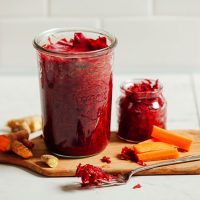
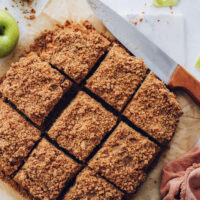

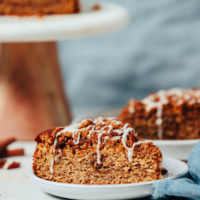




Robyn says
I’d love to hear some ideas about ways to use sauerkraut in a vegan diet? Thanks for your amazing recipes! 🌺
Hi Robyn! We like adding sauerkraut to salads and nourish bowls, but you can enjoy it anytime with any meal, or on its own. Hope this helps!
Sally says
I have made this a few times and I LOVE it and wouldn’t change a thing. SO GOOD. Thanks for the recipe.
That’s so great to hear, Sally! Thank you for the lovely review! xo
Sammy Walters says
Can I use caraway seeds in this recipe
Sure!
Debra Paulson says
I made this minus the turmeric because I didn’t have it. It was very tasty and made great turkey reubens.
We’re so glad you enjoyed it, Debra! Thank you for the lovely review! xo
Zarah says
I am on day 3 of fermenting this sauerkraut and when I opened the lid this evening to release the air as I have been doing, my liquid started to run out, it felt like a shaken can of soft drink. The sauerkraut has moved up to the top and I think if I took the lid off completely it would erupt. Have I done something wrong?
Hi Zarah, that sounds like it’s fermenting well! Perhaps the jar was just a little too full?
Priyanshi Jain says
I pressure cooked the beet have I done it wrong or it is okay
Hi Priyanshi, this recipe uses raw beets, so we would recommend using the cooked beet for something else!
David says
hi,
This is my first time making sauerkraut yesterday. I printed both imperial and metric recipes (cabbage was easier to measure in kilograms and the rest easier in the other measures). I used a food processor for the shredding as my attempt to use the mandolin failed. I do believe it is working and wife likes so we are happy. Big Thanks.
Woohoo! Thank you for sharing, David!
Chay says
Hello from Warrawee, Sydney! Made this sauerkraut three days ago, exactly as per recipe. Used home-grown organic beetroot and turmeric and store-bought organic for the rest of the ingredients.
It tastes delicious so far, like the ingredients are still fresh, but with an amazing added flavour. The mixture is becoming a little tangy, but I’m not seeing any bubbles, nor has there been any noticeable gas release when I open the lid.
I have topped up the water daily as it has definitely dropped below the top of the veges each morning.
As a first-time fermenter, my question is – does it have to bubble and produce gas to be ‘working’?
There’s no sign of mould and the veges have softened somewhat. It honestly tastes good enough to eat right now, but I am conscious that, being at the tail end of winter and with no central heating on, the temperature in our house hasn’t been that warm, so it’s probably got more time to go (and gas to produce!)
Hi Chay, we’re so glad you enjoy it so far! It sounds like it’s just taking longer with it being a cooler temperature indoors. We’d suggest trying to store it in a warmer spot of your home to see if that speeds up the process. But it sounds like it’s still fine!
Angelica says
I think the problem lies where you’ve been adding extra water daily, and diluting it, which is not allowing it to simply sit and ferment and do its thing. When you top it off daily, resets the time it ferment, back to square one
De says
I haven’t made this yet, but as I live in a very hot country (Jamaica), would the temperature be too high for this process – can fermentation be too quick? In the winter the lowest temperatures where we live are around 25 C and that’s at night. I don’t think the summer would be a good idea!
Looking forward to your input!
Thanks in advance.
Hi De, fermentation will likely happen a lot quicker there, so be sure to keep an eye on it and check sooner. You may also want to Google tips for fermenting in hot weather for additional guidance. Hope that helps!
Samantha Dailly says
Hi Dana. I’ve yet to make this but have been playing around with the idea of making sauerkraut for some time.
I’m wondering if it would be possible to omit the salt? I have high blood pressure and I’m taking steps to reduce my sodium intake so I’m curious if you think any adaptations to the original recipe would work.
Hi Samantha, the salt is necessary for proper fermentation, so unfortunately it won’t work to omit it.
Emma Swann says
This was delicious! And really easy to make. I loved the combination of flavours. I made it in an open jar and convered it when a tea towel so didn’t need to burb it and this worked well. Thank you very much for the recipe, I’ll make it again!
Great! Thanks so much for sharing, Emma! xo
Maureen says
My mother in law made saurkraut for years, with cheesecloth covering the large crock, stirring it every day and whatever other magic she did to make it taste so delicious. Nothing like homemade saurkraut.
Sally says
Hi, I made this recipe 11 days ago, suer easy and great instructions. My query is that I ‘burped’ it in days 1 and 2 and there was a pressure build up, but since then there has been no pressure. How do I know if it has fermented? I just tasted it and it tastes of slightly salty crunchy vegetables. Not tangy. Should I leave it for longer? And what clues do I get that something is happening?! Thank you! I SO want this to be a success!
Hi Sally, we’re wondering if maybe the room isn’t warm enough? If that seems like it might be the issue, we’d suggest transferring to a warmer area and giving it a little longer. Hope that helps!
Lea says
Thank you for sharing, this recipe works like magic!
It was my first time making sauerkraut and I am amazed how easy it was!
I used red cabbage (shredded), carrots (grated), beetroot (grated), salt. garlic (grated) and Japanese 7 spice mix (nanami togarashi).
Left it for 3 – 4 days and smells yumm..the taste was not too strong too ..now I can use this in making sandwich and making bigos stew..
We’re so glad you enjoyed it, Lea! Thanks so much for sharing! xo
Sieera Rolls says
Instead of fresh turmeric could I use the powder version instead or omit it entirely?
Either would be fine! If using powder, we’d suggest using less.
Raahema says
Can I use a screw top lid jar for making this? I haven’t got a glass air tight lid jar. Following rest of the instructions as it
Yes, that’s fine!
Ann Van Gampelaere says
I will try this, this looks doable. The video’s make all the difference. The are so helpful.
We’re so glad the video is helpful! Let us know how it goes, Ann!
Debra says
I made it and did not have turmeric, but used red cabbage, beet, carrots, ginger and garlic. I use the fermentation lids that have a pressure release valve and I have glass weights to keep the veggies submerged. I salted all , massaged a few minutes and let it rest for about 45 minutes and massaged again. I then had enough liquid when it was compressed in the jars. It smells good even at this point. I have made kraut with cabbage, carrots and apples which is also tastey.
Great! Thanks for sharing, Debra!
Rachel says
Hello – just made this, had all ingredients aside from turmeric so omitted it. Did quite a bit of massaging and there is not much liquid so for the first jar had to put over a cup of water in…. What do you recommend? Will it work? Room is 22 degrees Celsius: thanks
Hi Rachel, it should be okay!
Megan says
Hi! I made this a few days ago and have been a bit worried that I didn’t do it correctly. There wasn’t enough liquid to fill the jar all the way to the top and I didn’t catch the instruction about using water. If its been a few days is it too late to do this step or should I start again from the beginning? Please let me know what you think because I was really excited to try this.
Hi Megan, we’d suggest removing any kraut that is above the liquid line and the rest should be fine!
Jaime Gordon says
Hello, this recipe is (so far) delicious! Two weeks ago on 02/28/21, I followed your recipe and have a beautiful batch that is still fermenting on my kitchen counter. I’m in the suburbs of Philadelphia, and it’s still pretty cold here, so our indoor house temps range between 62 and 67 degrees. Here’s my concern: one thing I didn’t do was press down on the veggies each day. I was concerned about bacteria entering, but now realize that had I kept things better submerged that would have been safer. Anyway, I have ‘burped’ the jar every day since the start. Initially I did see some bubbles rise to the top, but after a few days I didn’t notice any more forming. All along each opening of the jar would yield a soft sounding release, which has me thinking it is in fact okay? There is nothing funky looking on the surface. When I open the jar it smells like the ingredients, so it’s strong, but not in a funky way. Since day 10 we’ve been sampling some daily, and I just tasted a fork-full and it’s delicious, still crunchy, and not salty. Honestly it tastes fresh! There was perhaps a touch more brine at the top for the first couple of days, but never more than a centimeter or so at any time. Now small pieces of the ingredients just break the surface. So my question is, would you 1) keep it fermenting another week (or even two) on the kitchen counter, 2) put it in the fridge and enjoy some on a daily basis, or 3) throw it away??? Thank you!!!
I wouldn’t throw it away – if it tastes fine and there’s no mold it should be safe! I’d keep fermenting – your temps sound kind of cool so try and keep it as warm as you can! This allows faster fermentation. Hope that helps!
Raymond says
Hi! I am planing to try this out soon.
May O ask you how do you sterilise used jars? What about the lids? Or do you use new ones?
Thanks
Hi Raymond, we sterilize the jars and lids by pouring boiling water over them. Hope that helps!
Raymond says
Great, thanx! Ill give it a try ;)
Jaime Gordon says
Thank you so much for getting back to me, I really appreciate it!
I put it in the fridge today but will pull it back out when I get home from work. If I may ask a follow up question– should I put a cabbage leaf in there as a ‘float-guard’ and add a weight at this point to effectively get the ingredients to rest below the brine? If it’s still fermenting, isn’t this still somewhat important??? Thanks again!!!
Yes, I use the cabbage leaves as a guard. I don’t have weights but you can do that to keep everything submerged!
kathy says
this looks great. can i use a regular lid (without a pressure seal) for this receipe?
Yes!
linda says
Great recipe and really delicious.5 star excellent.
We’re so glad you enjoyed it! Thanks, Linda!
Bob Monzo says
Why did one jar (of 5 jars) of fermenting red cabbage have a bluish color?
Hmm, good question! Is it possible there was some residual soap in the jar from cleaning?
Susanna says
Purple cabbage will create a blue colour in liquid.
Farnaz Karimian says
I’m so excited to try this recipe. You mentioned to keep it in a cabinet out of direct sunlight while it ferments; do i need to refrigerate it once it’s fermented? Thank you!
Hi Farnaz, yes! Refrigerating will slow the fermentation process, so transfer it there once it’s tangy enough for you.
Alana says
Can I make this without using beets? Thanks.
Sure!
ragini nagpal says
Can we make sauerkraut without cabbage?
You can make fermented beets or carrots!
Deb says
Hi, my sea salt is very fine so therefore the quantity will be greater if measured in teaspoons as opposed to actual weight measurement than regular salt. Could you please weigh the salt you use and put that measurement on the recipe too please.
Hi Deb! We didn’t weigh this particular amount, but roughly speaking 1 tsp salt = 5.9 grams.
Denise says
Hello, I made this 3 days ago. There is enough water to cover the cabbage but each day there is a quarter inch of darker brown cabbage that floats to the top. I keep pushing in down under the water. Will this still be good or does the brown mean that there has been oxidation? Also, is it possible there’s not enough water?
Hi Denise, The brownish layer is normal. Just keep pressing it down. Did you by chance top the sauerkraut with a whole cabbage leaf? That tends to help with keeping it down!
Stephanie says
The first couple of days when I opened the lid the kraut was bubbling and had risen right up to the lid. I pushed it all back down again and closed the lid and now a few days later is has stopped bubbling. I used my hands to do this (Washed them) but now i see i should have used an object not hands. Could this have contaminated the kraut or should it stop bubbling after a few days? Would it still be okay to eat?
I think it’s still OK to eat! It doesn’t always keep getting more and more bubbly in my experience. If there’s no mold, it’s tangy, and the taste is pleasant you’re good to go!
Genevieve says
Made my 1st ever sauerkraut a few months ago. I didn’t have beetroot or turmeric on hand, so used a white cabbages, carrots, ginge and garlic. Within the 1st week it smelt REALLY strong, but not off.
I opened the lids every second day as they were under a serious amount of pressure, compressing the contents each time. After approx. 2 weeks there was no more smell and after about 2 months we had our first taste with some honey-mustard eisbein. WONDERFUL!
Smells stronger (due to all the ginger & garlic) than it tastes and is a bit more sour than store bought kraut, but we love it! My husband has consumed nearly half of the jars (made 6) and has asked me to make more!
Thanks for another amazing recipe!
Way to go, Genevieve! We’re so glad you both enjoy it! Thanks so much for sharing!
Deborah Norvell says
Greetings ! I have made this recipe 3x so far, and I love it! I love the flavorabe notes of ginger and garlic. Thank you for your informative website.
We’re so glad you enjoy it, Deborah! Thanks for sharing!
Rebecca John says
I made this recipe a few months ago. It took two weeks to ferment as it’s a bit cold in Melbourne. It’s delicious and is keeping really well in the fridge. Even my daughter loves it. Making another batch very soon!
We’re so glad you both enjoy it! Thanks so much for sharing, Rebecca!
Chontelle Murphy says
I made this for the first time and was stoked when it started working on day 2, but day 4 and nothing id happening now. How do i save all my hars work.
Hmm, does it have any signs of mold or smell bad? You could try transferring to the fridge. Hope that helps!
Laurel says
I made this but I am just waiting for it to ferment now! I have a question, is it normal for it to smell a bit off at first? I am having a hard time getting all of the ingredients under the liquid even with added water. Is that alright or will the top pieces rot and ruin the rest of it? Thank you so much!!
Hi Laurel, hmm, we haven’t experienced it smelling off at first. We wonder if some bacteria was introduced in the process or something wasn’t sterilized? It’s best for it to stay under the water, but if it isn’t, you can scoop off the top layer. Hope that helps!
Sam says
Hi,
When transferring to the fridge from the jar I’m going to use small plastic tubs. Do we remove and discard the brine and just keep the fermented cabbage or do we keep the brine as well as the cabbage and move that to the tubs to go in the fridge?
Keep the brine!
Deb says
Could you give me the weight of the salt and cabbage instead of measurements in cups and teaspoons please as my sea salt is very fine and therefore the quantity will be higher measured in teaspoons than in weight. Also in the UK we don’t use cups.
Many thanks. Can’t wait to try it out.
Hi Deb, you can find a weight measurement for the cabbage by clicking “metric” beneath the ingredients header. We don’t have a weight measurement for the salt as it was our understanding that teaspoons are used there too?
Matt says
Hi Dana
Just wondering if this can be made with a machine? For example add all the ingredients to a KitchenAid, mix and add to the jar? The massage for 10 minutes part is turning me off a little. How about putting it all in a NutriBullet and then in a jar to ferment?
Cheers
Matt
Hmm, we’ve never tried it, but maybe? Let us know if you give it a try!
Lora says
Potato masher works for me. I don’t like using my hands as salt irritates the skin.
Thanks for sharing, Lora!
Takiya says
That’s a great idea! Thank you!!!
Tara says
Hi Dana!
It’s been 8 days and the liquid is no longer covering the cabbage. Should I add more liquid this late in the game or just assume it has done what it was supposed to do and is done?
Hi Tara, we’d suggest just scooping off and discarding any that is above the liquid.
Amirah Asraf says
Is it okay if my jar is like 60 per cent full, cos i scraped off the top layer of the sauerkraut that turned brown (read somewhere that that can happen when the top part is oxidized due to not being fully submerged in the brine). This is day-2 in the whole fermenting process so should I add more cabbage leaves on top or just let it be?
Hi Amirah, we’d recommend scraping off any that isn’t submerged as it can oxidize and get moldy. Hope that helps!
Jessie says
Hey Dana! First, I just want to say how much I love this website and your cookbook. You have completely changed the way I eat and I’m so grateful to you! … Sauerkraut. Mine has been sitting for a couple days now and the liquid is pretty much sitting level with the cabbage, not actually covering it. Should I add a bit of water to cover the cabbage?
Thanks so much!
I’d say press down a bit to make sure it’s fully compressed. If it still doesn’t cover at that stage, a little water is fine.
Berrin says
Thank you for sharing this recipe! I made a mistake and added 1 1/2 half tbsp salt :( I tasted the liquid and it was too salty :( I’ll keep it and see the result but I was wondering if there was anything to do now (this is the first day of the fermentation) or is it just rinsing it before eating.
Thank you!
Hi Berrin, we wonder if you could make another batch without salt and mix the two?
Berrin says
I don’t have any cabbage left and hard to find organic ones because of quarantine but i guess carrots and beet will do good. I’ll try that. Thank you for your quick response.
Jessica says
Can you can this sauerkraut?
Hi Jessica, canning will destroy the probiotics, so we wouldn’t recommend it.
Phil says
Can I use Morton’s salt?
Hi Phil, we haven’t tried it, but don’t see why not! Let us know how it goes!
Mollie says
ok so I see some brown foam ;/ am I able to scrape this off press down and continue to ferment?
That should work!
Mollie Christeen Douthit says
stellar! I tried it and there is zero weirdness on top today. :)
Yay! Glad to hear it!
Lisa Kuspira says
Hi, this is my first time fermenting and it looks great in the jar. However, I misread and only left an inch of air at the top and now I’m paranoid the jar might explode as it expands. It’s only been fermenting for a few hours. Should I remove some of the sauerkraut and put the lid back on. It’s a rainy 15 degrees in Melbourne today, so not that hot.
Thanks for your help. Lisa
I’d say yes! Otherwise it will likely spill over. Otherwise you can put it on a rimmed plate or bowl to catch any spill over (which has happened to me before).
Linda says
Made this for first time. Why is the cabbage turning black on the very top layer of cabbage? Is this mold? Should I discard this? If so what went wrong ?
I’d say discard anything black. A little mold is not typical but as long as it’s removed and the rest of the kraut looks OK, that’s fine. It could have just been set out too long in too warm of a climate or in direct sunlight?
Steph says
Thanks for this! My first venture into the fermentation world!
Question: I made this last night, and it’s sitting out on my kitchen counter, away from direct sunlight. I don’t see any bubbles, or gas, forming. Is this normal? Would I need to add more salt? ?♀️
Thank you!
Hi Steph, it may just be taking a little longer. Have you noticed any differences yet?
Steph says
I have! There was definitely some activity the next day- and some spilling over too! 2 weeks later, I’ve tasted it and am so pleased! I’m so excited by how simple that was! Thanks!
Yay! So glad it worked out well! Thanks for sharing!
Misk says
You will end up with yellow hands if you use turmeric powder! ? smells fab, looking forward to trying.
Katherine says
I used turmeric powder and had no yellowing, but my hands were purple-tinted from the beets.
Robin says
I made this take on sauerkraut along with a more traditional all-cabbage one and this is by far the favorite! Just as described, and easy to make with just a few simple kitchen tools.
CHRISTOPHER JAMES says
Thank you. Very easy recipe to follow. It really does take 10 minutes of cabbage massaging to get the liquid release going. Liquid will start to release after a few minutes, but keep going for the whole ten. As a bread maker also, I found this experience therapeutic and much like kneading bread by hand. I added carrots. Didn’t have beets, but will add those next time. The carrots give it a nice orange color. I used my Chinese wonton roller (wooden) to push the sauerkraut down into the liquid each day. I washed the roller before and after using it.
Thanks for sharing, Christopher! Next time would you mind adding a rating to your review? It’s super helpful to us and other readers! xo
Sue says
Can I use powdered ginger and tumeric?
It won’t be quite as flavorful, but you can.
Odessa Kelebay says
Is it an issue if the cabbage is poking above the liquid level? I pushed it down before I sealed the jar, and originally it was fully submerged, but after 20 minutes, bits of cabbage were poking up out of the liquid. Is that okay?
That’s ok! As long as it’s mostly submerged :D
JoAnne says
Yummy!
JoAnne says
This is great, i’ve made it twice now, and it’s very popular with my family! Today i plan on using your apple variation. Somebody suggested using a smaller jar filled with water as a weight to push the goodies down into the liquid… i’ve done that, and filled it with hot water – only at the beginning – to get things started quickly. Seems to work! Thx.
We’re so glad you enjoy it, JoAnne! Thanks so much for the great tip and lovely review! Next time, would you mind leaving a rating with your review? It’s super helpful for us and other readers. Thanks so much! Xo
Mark says
Hi all. I have 2 suggestions and a question. To prevent stuff from floating, I put the cabbage leaf on top and then a glass weight and stainless steel spring. I use starter culture so the process is accelerated in my case so I’m concerned CO2 will be produced much faster then the traditional method. I want to make sure as little as possible gets to the surface of the brine under pressure. The surface is where yeast (white film) and mold form. There’s also a neat product I intend to try called pickle pusher. It’s a plastic ring with mesh screen in the middle to prevent anything getting above the brine at all.
Also an airlock helps keep air from getting in and allows CO2 to vent. That way you dont need to burp the container, which could also allow mold to enter. I now ferment in 1/2 gal Mason jars having moved up from quart size. I spent good money on airlock lids with charcoal filter but you can just as easily get a 1/2 dozen silicone ones from Amazon for a couple of bucks. Same thing for the glass weights, they’re not too pricey although the springs were a bit over $20 for only 3.
Now my question. Every time I try to ferment sugary stuff like carrots and beets I get wicked yeast film and mold forms 1/2 the time. I found that natural remedies for Candida such as extracts of garlic, grapefruit seed, oregano and olive leaf help but not eliminate the problem. I’m obviously pretty conscientious about what I’m doing, so does anyone have any tips and tricks they could share?
Interesting! We haven’t had that experience with beets and carrots, but they can of course just be left out or substituted with more cabbage. And thanks for sharing the tips! So helpful.
Susan Davis says
I am about to make this! It sounds delicious. And it will be my first ever fermentation recipe! I’ll keep you posted.
Excited to hear how it goes for you =)
Sherri says
I made this today, probably could’ve added some more beets because I used mostly green cabbage so it doesn’t have that really rich color. I Added in a Ciupke if Thai chilis as well. It hasn’t fermented yet but it smells absolutely delicious. And it taste phenomenal, even “raw” Thank you!
Thanks for sharing, Sherri!
Stewart Totten says
On another site I saw a good idea regarding keeping the cabbage submerged. Fill a plastic sandwich bag (or freezer bag) with water, leave the top open, put it inside the top of the jar with the plastic bag over the rim of the jar, put the ring on to hold it in place. The bag full of water holds the cabbage down.
Thanks for sharing, Stewart!
marty says
i didnt use this recepie but used purple?green cabbage, carrots , hot peppers, garlic and some butternut squash, i put it in a 1 gal crock salted and mixed and stirred and put a glass tea cup saucer on top to keep it in the brine/juice. this is my first time trying this
Elaina says
This recipe is PERFECTION! This was my first ferment, and so far I’ve made it twice. It is a permanent staple now! I use all red cabbage and have to add just a little filtered water. It’s SO good! And mine is the most beautiful purple-pink color. I’ll have to photograph it! Thank you for sharing it!
Thanks so much for the lovely review, Elaina. We are so glad you enjoy it! Next time, would you mind leaving a rating with your review? It’s super helpful for us and other readers. Thanks so much! Xo
Soumyo Biswas says
For those living in hotter climates (average temperature here tends to be around 25-30 degrees Celsius), how much time do you need to keep it fermenting for? How does one know if there are any signs of spoilage in it? I’m a bit paranoid when it comes to mycotoxins and botulism.
Great question. Warm climates do accelerate fermentation so check around 24 hours, then 36 hours. If it’s already tangy that may be all you need!
Jen says
I live in Queensland, Australia and it is very warm especially in summer when the temperature is over 35 deg C most days. I ferment for only half the day, and I use a cabbage leaf with a stone as a weight.
Margaret says
I dont have any fresh Ginger or tameric, Can i use powder instead.
Thank You
Hi Margaret, we aren’t sure that will work as fresh tends to have a different/stronger flavor. But let us know if you give it a try!
Zafar Abbas says
Please let me know if Alcohal is also produced during process of fermentation in making sauerkraut
No. And if it does, it’s extremely minimal.
Kara says
I am on day two. My kraut is under the brine, but when I opened the lid, I did not notice any air releasing or bubbles. What could be wrong?
Just keep going. It may be that it’s too cool in your space, so make sure it’s somewhere warm and keep pressing the top down to ensure it’s under the liquid. I’d say leave it for a week and check back!
Candy says
I love this recipe and have made it several time. However, I have reduced the garlic quantity as there was too much of garlic flavor in the sauerkraut.
We’re so glad you enjoy this recipe, Candy! Thanks for sharing your modification!
Lynn says
Hi there… I have tried several of your recipes and love all of them!
I want to make sauerkraut or kimchi and have been wondering why there is no rinsing process in the start of making sauerkraut unlike kimchi which most recipe ask for rinsing the salt water / brine before mixing with the other ingredients. Perhaps you know the answer and are able to help? Thanks in advance!
It’s just not necessary because you massage it with your hands, which softens the cabbage.
Michelle says
I’m in the process of making this sauerkraut, but my sauerkraut won’t stay under the brine. I’ve been pushing it down into the brine and even adding water, but it rises and the top layer gets a weird brownish color. I’m at day 3 right now. What should I do?! Not sure how to fix the batch I have going…
The brownish layer is normal. Just keep pressing it down. Did you by chance top the sauerkraut with a whole cabbage leaf? That tends to help with keeping it down!
Memmsta says
very teasty
Felicia says
I buy the premade pickle flavored at the health food store. How can I make this the same flavor?
Hmm, we haven’t tried that and aren’t really sure! If you figure it out, we would love to hear what you learn!
Al says
This is a *fabulous* recipe and I modify it to make a spicy dill pickle-y flavor by getting rid of the carrots and beets and add a shallot, a couple of tablespoons of fresh dill and 2 Fresno chilies. It turns out super tasty and fulfills my pickle cravings (also very good on sandwiches/burgers/brats).
Thanks for sharing!
Janet says
Looking forward to starting fermentation. Sorry for maybe asking a silly question but are the beets raw or cooked?
Hi Janet, the beets are raw. Hope that helps!
Alexandra Colacito says
Where do you find fresh turmeric?
Most markets and groceries should carry it!
steve says
this looks fabulous and nutritious and will definitely try it. however, I am wondering whether the antibiotic qualities in the garlic effect the probiotic qualities of the finished sauerkraut. any idea on this ? thanks.
Interesting question, Steve! We wouldn’t think so since many foods have antimicrobial properties (ginger and turmeric included). But if you are concerned, you can reduce or omit.
joyce says
I read that garlics are prebiotics , which are what probiotics feed on.
Jeannette says
I have made plain sauerkraut a few times and I really like it. This flavor combo sounds great! I have a question. With my last batch, I had left over brine. Can this be added to a new batch? I actually ended up drinking it, but I wondered if it would help the fermentation process.
Eva says
Hi, I found that adding a little leftover brine to the next project is excellent for jumpstarting the fermentation process. Can’t wait to try the beautiful beet combo.
Kathy Shaw says
Just wondering – can I can this after fermenting? PC or WB and for how long etc.?
Jeannette says
Canning will kill the probiotics, so it is not a good idea.
angela says
are the beets fresh?
can you use turmeric spice? rather than fresh?
thanks
Yes, fresh beets! You could try that, though we haven’t and can’t say for sure how it would go. Let us know if you experiment!
Mags says
Would this work if you didn’t add the beat?
Not sure as we haven’t tried without! Let us know how it goes :)
MeLee says
I made this recipe and forgot to push it down. It has been about a week now…. and it has also gotten discolored on the top. Is it still fine to eat or should I skip it and start over?
Please HELP
Matt J says
Hi everyone, I started this recipe a couple of days ago and did push down but still noticed some brown at the top. Is this still okay to continue fermenting? Thanks.
Robert says
It happened to both jars and I just mixed it with the rest before serving. Seems to be a normal oxidation process and does not harm the taste neither my health, if it can help.
The brownish layer is normal. Just keep pressing it down. Did you by chance top the sauerkraut with a whole cabbage leaf? That tends to help with keeping it down!
petrus says
ingredients state 1 1/2 – 2 tsp but that should be 1 1/2 – 2 tbsp in my opinion.
i didn’t get quite enough liquid so topped jars up with some boiling water.
great recipe. thanks for sharing.
Tatiane Hannisdal says
I made it like a “full salad”: used broccoli, onion and parsley too. Next time I’ll take out the parsley and put ginger and turmeric. And bay leaves! My mom says it helps to be crunchy in the end.
And cocumber pickles is the same process! Cocumber, salted water, bay leaves and garlic. Delicious! I’ll never buy pickles at the grocery store again!
Tatiane Hannisdal says
And black pepper (whole) too, for the pickles! ;-)
Yum! Thanks for sharing, Tatiane!
jkramer says
For those that are concerned about salt, the salt is needed for fermentation. If you are on a restricted salt diet you can rinse the finished sauerkraut before eating or cooking with it.
Bob Bradford says
Is there any reason I cannot use a plastic jar? Glass containers are non existent in this part of Ecuador. TIA
Hi Bob! You could probably try using plastic jars that are made for canning specifically, but we wouldn’t recommend using a generic plastic jar as they break down much quicker than a glass jar, especially when repeatedly being disinfected with boiling water.
Cynthia says
Hi, where in Ecuador are you? I’m in Cotacachi and have found a few large glass jars in the canister section of the store. They’re kind of square and hold almost 2 gallons. They have plastic lids but I don’t use them. I use the plastic bag of water methods of holding everything under the juice. Keep on the lookout, I bet you’ll find something.
Melissa Ramsey says
I just found your site. I made a batch found on another site. I read on there to wait 4-5 hours before adding any liquid to it. Yesterday, I made my first batch ever. It didn’t have much liquid, but by last night it did. I can’t wait to try it. When making it, I thought of adding garlic and/or shredded carrots, but wasn’t sure if I would like it. I don’t like Caraway seeds. This recipe sounds really good, but not sure is I would like to make something I may wind up not liking. I like all the ingredients in other things. Can you tell me what it winds up tasting like?
It’s tangy, crunchy, and garlicky!
Lori K says
Hi! Love your site! Everything I’ve made has been awesome!
I’ve been wanting to try fermented veggies for a while! Made this a couple of days ago, and today I noticed the top layer is discolored (more brown; less vibrant). Is this anything to be concerned about?
The brownish layer is normal. Just keep pressing it down. Did you by chance top the sauerkraut with a whole cabbage leaf? That tends to help with keeping it down!
Derry Schembri says
I made it exactly like you said except used dried turmeric . Turned out brilliant absolutely love it i had tried it before shop bought and did not like it but mine yummy . left it 14 days and now it is great tasting.Now need to make more different recipes please is you got any.Thank you
Kyl says
Does the pro-biotic increase the tangier it gets?
I believe so, yes.
Kyl says
I might be pushing it, but could you explain why?
Ragg2 says
Sauerkraut is made by a process called lacto-fermentation. To put it (fairly) simply: There is beneficial bacteria present on the surface of the cabbage and, in fact, all fruits and vegetables. Lactobacillus is one of those bacteria, which is the same bacteria found in yogurt and many other cultured products. When submerged in a brine, the bacteria begin to convert sugars in the cabbage into lactic acid; this is a natural preservative that inhibits the growth of harmful bacteria.
Rosemary Leicht says
Hi! My kraut is in the process of fermenting right now, but when I’ve tamped it down ive noticed a discoloration on the top layer- it seems a little more brown/ Orange but it smells fine (tangy like sauerkraut but not off like most bad things do) is this safe? Ian it just from the exposure of the top layer? Or maybe because i used a little powdered tumeric instead of fresh?
Imma says
I had the same problem, and I used fresh turmeric. The discolored top layer did taste fine, but has me wondering why it lost all the red and went beige… I disinfect the fork or glass I use with boiling water before pressing down and wait until it’s room temp… but perhaps the tools are still warm when I use them and that causes it? The discoloration definitely seems “off”.
Julie says
I just made this about 6 days ago and was wondering the same thing. Did you end up eating yours? (I realize your comment is several months old, sorry!)
The brownish layer is normal. Just keep pressing it down. Did you by chance top the sauerkraut with a whole cabbage leaf? That tends to help with keeping it down!
Justine Reif says
I tried this recipe out yesterday — looking forward to eating it in a week or so. One thing I noticed (maybe it was mentioned above in other comments, sorry if it was), is that your fingernails might stain after handling the turmeric. Mine are still stained yellow even after lots of scrubbing. Wear gloves if you are concerned about this =)
Denise Rice says
hi,
I bought everything to make this recipe but forgot the beets (duh)
Can I just leave them out or is there a substitute?
Can I just leave them out.
thanks.
We haven’t tried leaving out the beets, but it should still work! Let us know how it goes!
Katie says
I have not fermented anything before. Do I taste it every day? How do I tell when it is fermented enough? (I don’t want it super sour.)
Hi Katie, sample occasionally with a clean utensil to test and see if it is at the right stage for you. Once it has reached the desired tanginess, cover securely and transfer to the fridge.
rmilo says
This version is very interesting to me, and I will definitely try this different flavored kraut (tumeric, & ginger)! My preparation is quite different and have to say……I really love adding sweetness to the sauerkraut, then let it marinate.
I sweat onions first, then fresh cabbage in veggie broth with a little garlic, salt, and pepper to taste (you can modify by using prepared plain kraut from jars or bag, but of course rinse and drain first, then add to the sweated onions to meld).
Continue cooking down the cabbage by adding apple cider or juice, chopped apples, caraway seed, and after a while, add some paprika for color until cabbage is all very soft! It’s more Austrian-Hungarian style (tangy, sour & sweet, possibly similar to what some may call a sauerkraut stew, but for my family it’s sauerkraut?) I put them in clean jars (using no soap or heat, only water). You can serve it after 2-3 days – the longer you can allow it sit, the better it tastes! It never lasts, though I try to make several extra jars & keep refrigerated, they’re gone… 1month, possibly 2 months max if I’m very, very lucky!
Marie says
I just made this tonight. I really didn’t get much liquid. I mixed for 10 minutes and then let sit maybe another 10-15. I ended up adding water to the jars at the end.
Also I used ground turmeric because fresh is non-existent around where I live.
Looking forward to trying it once it’s ready to go!!
Mary Karen says
Thanks for sharing such a wonderful recipe. I usually make fermented carrots (very easy), but never sauerkraut, I´ll try at my home. Thanks for sharing…
julie says
Your recipe looks Fantastic! Can’t wait to try it!
I’ve used freshly made celery juice for the extra liquid
if needed and it worked great! Read that on a blog post
somewhere but can’t remember the gal’s name.
Deb says
Can you make this with 1/4 to 1/2 Tsp of salt?
The salt is what helps draw out the moisture that covers the vegetables to promote fermentation. So I highly recommend using the recommended amount.
Nick says
You do not want to go with less than the recommended amount of salt, as you can get sick. Dr. Weil mentions this when he is discussing making sauerkraut and the health benefits:
‘So is it healthy? “There is a range of salt concentrations you can use, and I tend toward the minimum,” says Dr. Weil. “So unless you need to restrict your salt intake for some specific reason, that’s not a concern.” But be aware – too little salt can lead to spoilage and food poisoning. Don’t go below three-tablespoon-per-five-pound limit, and never eat sauerkraut that is slimy, excessively soft, discolored or off-flavor.’
I’d recommend weighing the produce that you use before cutting, or grating to see how much salt you need and don’t go below that. For example, say that you have 2 pounds of veggies. Then multiply by 3/5 to get 1.2 Tbsp of salt needed, which is about 1 Tbsp plus 1 scant tsp, since there are 1 tsp per Tbsp. This would be the minimum amount of salt to safely make it. You can go with more, but not less.
Deb says
Yes, I understand. But it basically puts sauerkraut off the menu for me. I’m not supposed to eat a lot of salt due to a medical problem. I’m very healthy otherwise, but salt is not an option for me. That’s why I was asking.
ROG says
rinse in water before eating
Joanna @DIY Project says
Thanks for sharing such a wonderful recipe. Gonna try this out. Awesome sauerkraut DIY tutorial you made.
Hope you love it, Joanna!
E says
Is there a way to make sauerkraut without salt for a salt free diet?
Hmm, I don’t think so. It seems essential in the preservation and natural fermentation process.
Ragg2 says
No, you need the salt to kill of any unwanted bacteria. Otherwise it just goes off. Lactobacillus is one of those good bacteria, which is the same bacteria found in yogurt and many other cultured products. When submerged in a brine, the bacteria begin to convert sugars in the cabbage into lactic acid; this is a natural preservative that inhibits the growth of harmful bacteria.
Susie Prentice says
Lovely recipe- Thankyou
Could I ask I few questions please …
What do you do if you don’t have enough liquid to cover the jars ?
How long can you keep in the fridge after fermentation?
Is it ok to freeze
Many thanks !
I wouldn’t freeze this. It can keep refrigerated for months (I’ve read up to 6). And if you don’t have enough liquid to cover the jars apparently you can add a little water.
Mikhael NISNER says
Hi Dana, Just completed the above recipe and the cabbage softened up nicely.
Two questions –
1 – definitely short of liquid… so I added a little water to cover the cabbage
2 – as I only had a slightly larger jar, I’ve got about 3 cm of space between the top of the liquid and the lid. Do you feel I have a problem? or have you got a suggestion for me?
Mikhael
Hi Mikhael, depending on the water content and freshness of the veggies, water may need to be added- so that’s fine. As for the amount of space, it could bubble over or not ferment properly, so you might want to transfer some to another jar or at minimum, put a plate under the jar to minimize any mess. Hope that helps!
Lyn says
I always make extra brine by mixing salt and water otherwise there’s not enough liquid.
Karen Monteith says
I have made sauerkraut but just cabbage, salt and garlic. I will try this. Thanks for sharing the recipe.
Karen
Anne says
I’ve been afraid to try homemade sauerkraut, because I didn’t want to make a mistake and end up getting sick… But I know how healthy it is. Maybe I’ll give it a try….
David A says
I have made sauerkraut numerous times, usually plain, sometime ginger, ferment carrots alone and with ginger which were great. This I have to try as the combo looks incredible and definitely going to do this.
Silvia says
Thanks for the recipe! I usually make fermented carrots (very easy), but never sauerkraut, I´ll try. Just a question: is it possible to use ground ginger and turmeric, or it´s only possible with the fresh ones? Thanks again!
Amy says
This is the question I have as well. We can easily find fresh ginger but have no where close to us that carries fresh turmeric.
I’d say give it a go and see if it works! I haven’t tried it myself, so let us know if you do!
Cheryl says
Check with local health/whole foods stores for fresh tumeric. While you can use dried, it will not taste the same as a fresh food that ferments with the veggies. Re added water – I second what Joelle mentioned. Some veggies might need a bit more coaxing or patience before they release their water. It’s also very important to use fresh vegetables. Wilted veggies won’t work well.
Silvia says
Thank you! ;-)
Carol Abnett says
In Australia we can buy fresh Tumeric in Asian grocery stores or good green grocers.
I have just made this now and looks interesting, I have only tried bought Sauerkraut and didn’t like it so I’m hoping this turns out tasty.
Y says
I’ve never fermented anything before but would like to start. Silly question but do you wash the vegetables first ? Thanks.
Joelle says
Wash them with water, but don’t wash with any of those vegetable washes. Also, wash your hands and jars, but don’t use any disinfectant soap or anything like that. You WANT microbes and those kill everything!
I know Dana says to sterilize your jars, and I’m NOT arguing with her (because she’s awesome and I love this site), but I’ve read a lot on this and most everyone says you don’t need to do this step because it’s not like canning, just use clean jars.
It’s really fun to ferment and while I swear I’m not out to promote the book Fermented Vegetables, I don’t know the authors or have any link to them, I’ve found it invaluable for answering all the questions I had. Now I’m free to try recipes like this one knowing I have a good idea of how to do it!
Y says
Thank you Joelle for the tips and advice! Feeling much more confident in giving this a go!
Brittany Audra @ Audra's Appetite says
I honestly thought for sure you had to add vinegar to make sauerkraut? Shows how much I know…love how approachable this is!
Mollie says
Do you think there would be anything wrong with using a head of Napa cabbage? I have a whole head in the fridge and usually I would make kimchi, but this looks like another great idea!!
I think that would work! Let us know how it goes.
Chelsea Fredrickson says
I’ve been wanting to make my own sauerkraut for so long (I eat so much of it!), but it always seemed so daunting to me. Thank you for sharing your gift with us! I cant wait to make this…every week ?
Joelle says
This sounds good. I’m making a lot of fermented vegetables, primarily using the cookbook Fermented Vegetables by Kirsten and Christopher Shockey. One thing they are adamant about is never adding water to your brine. As I’ve made other recipes where you do, I have to say after trying theirs that I agree with them. They turn out much better if you don’t. They give a few tips for getting more juice out of your veg, but one of them is to let it rest for an hour and then come back to it. I like your recipes so I’ll probably try this one, thanks! Oh, in their hot and smoky kraut they put peppers in from the start, both sweet or hot.
Thanks for sharing!
Jay B says
Think there would be any harm in adding finely chopped jalapeno pepper for some spice? Not sure if that would interfere with the fermentation process?
Laura says
I haven’t added it to the beginning of the fermentation process, but I have added it after it’s done and left it to almost ‘pickle’ in the jar. I loved how it turned out
Charlie. says
I have used very hot chillies in the making of fully fermented Indian pickles and they do not interfere in the fermentation at all.
Jay, I think that would be lovely.
Evelyn Barney says
The thing about jalapeno is they don’t have a ‘standard’ of heat. Most seem mild to me but then again . . . If hot is your thing and you don’t mind – GREAT! I’m posting this more for the capsicum delicate here. For some odd reason, I adore horseradish and ginger in what my (hot food loving) son calls ‘medicinal quantities’ but peppers and I have a more delicate relationship. Anchos, OTOH, have never caused me tummy burn or upset.
Bongie says
Hi i used tap water instead of filtered water as the liquid was not covering. Should i discard
Watch for mold and weird smells. Otherwise you should be good.